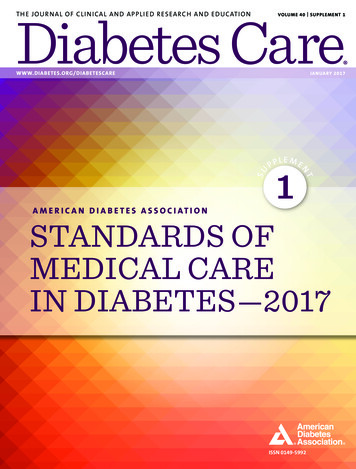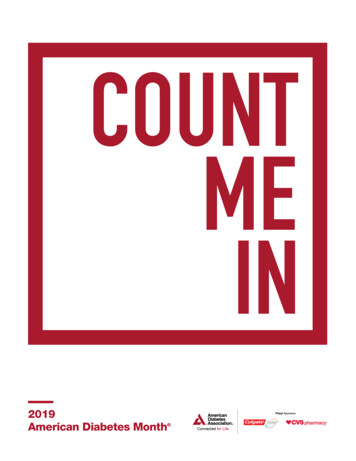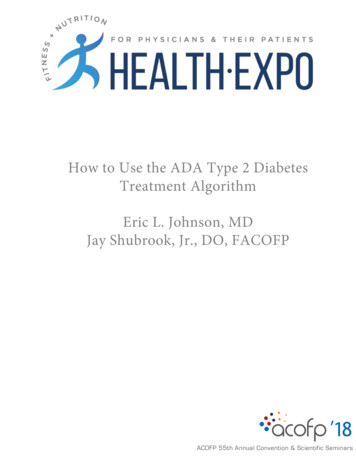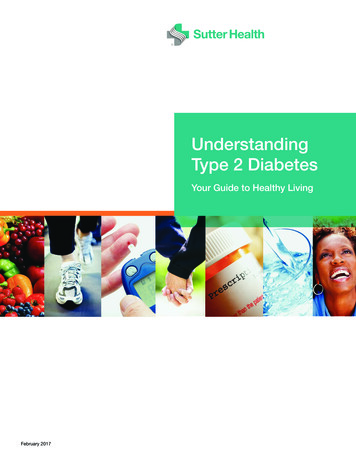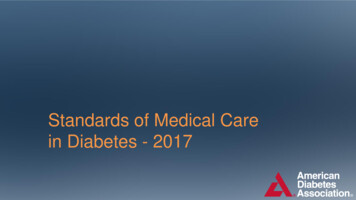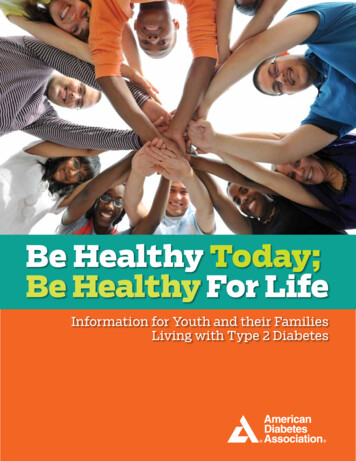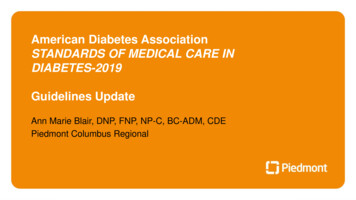
Transcription
American Diabetes AssociationSTANDARDS OF MEDICAL CARE INDIABETES-2019Guidelines UpdateAnn Marie Blair, DNP, FNP, NP-C, BC-ADM, CDEPiedmont Columbus Regional
Presenter Financial Relationships DisclosureAnn M. Blair, DNP, FNP, NP-C, BC-ADM, CDE:Speaker’s Bureau: Sanofi
Key Learning ObjectivesAt the end of this presentation, the attendee should be able to: Identify the recommendations and updates in the 2019 American DiabetesAssociation’s Standards of Care Discuss available resources and ways to access the Standards of Care3
Objectives The American Diabetes Associations Standards of Medical Care in Diabetesis updated and published annually in supplement to the January issue ofDiabetes Care Includes the most current evidence-based recommendations for diabetes and treating adultsand children with all forms of diabetes Evidence levels to support recommendations: A: Clear evidence from well-conducted, generalizable randomized control trialsthat are adequately poweredB: Supportive evidence from well-conducted cohort studiesC: Supportive evidence from poorly controlled or uncontrolled studiesE: Expert consensus or clinical experienceAmerican Diabetes Association. Diabetes Care, 2019;42(Supplement 1):S1-S24
Improving Care and Promoting Health in Populations New data on the financial costs of diabetes to individuals andsociety:In 2017, the cost of diagnosed diabetes was327 billion, an increase of 26% since 2012 Because telemedicine is a growing field that may increase access tocare for patients with diabetes, discussion was added on its use tofacilitate remote delivery of health-related services and clinicalinformation.6
Classification and Diagnosis of Diabetes Based on new data, the criteria for the diagnosis of diabetes waschanged to include two abnormal test results from the same sample(i.e., fasting plasma glucose and A1c from same sample). Additional conditions were identified that may affect A1c testaccuracy including the postpartum period.7
Classification and Diagnosis of DiabetesCriteria for the Diagnosis of DiabetesIn the absence of unequivocal hyperglycemia, a diagnosis requires two abnormal test results from the same sample or in two separate test samplesFPG 126 mg/dL (7.0 mmol/L). Fasting is defined as no caloric intake for at least 8 h. *OR2-h PG 200 mg/dL (11.1 mmol/L) during OGTT. The test should be performed as described by the WHO, using a glucose load containing theequivalent of 75-g anhydrous glucose dissolved in water.*ORA1C 6.5% (48 mmol/mol). The test should be performed in a laboratory using a method that is NGSP certified and standardized to the DCCTassay.*ORIn a patient with classic symptoms of hyperglycemia or hyperglycemic crisis, a random plasma glucose 200 mg/dL (11.1 mmol/L).8
Prevention or Delay of Type 2 Diabetes This section was previously Section 5 and is now located before theLifestyle Management section to better reflect the progression oftype 2 diabetes. The nutrition section was updated to highlight the importance ofweight loss for those at high risk for developing type 2 diabetes, whoare overweight, or obese. Because smoking may increase the risk of type 2 diabetes, asection on tobacco use and cessation was added.9
Comprehensive Medical Evaluation and Assessment ofComorbidities New text was added to guide health care professionals’ use of language tocommunicate with people with diabetes and professional audiences in aninformative, empowering, and educational style.A diabetes care decision cycle figure from the ADA-EASD consensus reportwas added to emphasize the need for ongoing assessment & shareddecision making to achieve health goals and avoid therapeutic inertia.A new recommendation was added to explicitly call out the importance ofthe diabetes care team and to list the professionals that make up the team. 10
Decision Cycle for Patient-centered Glycemic Management in Type 2Diabetes11
Comprehensive Medical Evaluation and Assessment ofComorbidities The table listing the components of a comprehensive medical evaluationwas revised, and the section on assessment and planning was used tocreate a new table.A new table was added listing factors that increase risk of treatmentassociated hypoglycemia.A recommendation was added to include an assessment of the 10-yearatherosclerotic cardiovascular disease (ASCVD) risk as part of overall riskassessment.The fatty liver disease section was revised to include updated text and anew recommendation regarding when to test for liver disease.12
Assessment and Treatment Plan ASCVD, atherosclerotic cardiovascular disease Assessment and treatment planning is an essential component of initial and all follow-up visitsAssess risk of diabetes complications ASCVD and heart failure history ASCVD risk factors (see Table 10.2) and 10-year ASCVD risk assessment Staging of chronic kidney disease (see Table 11.1) Hypoglycemia risk (Table 4.3)Goal setting Set A1C/blood glucose target If hypertension present, establish blood pressure target Diabetes self-management goals (e.g., monitoring frequency)Therapeutic treatment plan13 Lifestyle management Pharmacologic therapy (glucose lowering) Pharmacologic therapy (cardiovascular disease risk factors and renal) Use of glucose monitoring and insulin delivery devices Referral to diabetes education and medical specialists (as needed)
Assessment and Treatment PlanAssessment of Hypoglycemia RiskFactors that increase risk of treatment-associated hypoglycemia14 Use of insulin or insulin secretagogues (i.e., sulfonylureas, meglitinides) Impaired kidney or hepatic function Longer duration of diabetes Frailty and older age Cognitive impairment Impaired counterregulatory response, hypoglycemia unawareness Physical or intellectual disability that may impair behavioral response to hypoglycemia Alcohol use Polypharmacy (especially ACE inhibitors, angiotensin receptor blockers, nonselective β-blockers)
Lifestyle Management More discussion was added about the importance of macronutrientdistribution based on an individualized assessment of current eatingpatterns, preferences, and metabolic goals.There is not a one-size-fits-all eating pattern for individuals with diabetesand meal planning should be individualized.Recommendation was made to encourage people with diabetes todecrease consumption of both sugar sweetened and nonnutritivesweetened beverages and use other alternatives, with an emphasis onwater intake.The sodium consumption recommendation was modified to eliminate thefurther restriction that was potentially indicated for those with both diabetesand hypertension. 15
Lifestyle Management Additional discussion was added to the physical activity section to includethe benefit of a variety of leisure-time physical activities and flexibility andbalance exercises.The discussion about e-cigarettes was expanded to include more on publicperception and how their use to aide smoking cessation was not moreeffective than “usual care”. 16
Glycemic Targets This section now begins with a discussion of A1c tests to highlight thecentrality of A1c testing in glycemic management.The self-monitoring of blood glucose and continuous glucose monitoringtext and recommendations were moved to the new Diabetes Technologysection.To emphasize that the risks and benefits of glycemic targets can change asdiabetes progresses and patients age, a recommendation was added toreevaluate glycemic targets of over time.The section was modified to align with the living Standards updates made inApril 2018 regarding the consensus definition of hypoglycemia. 17
Glycemic TargetsGlycemic Recommendations (for many non-pregnant adults with diabetes) More or less stringent glycemic goals may be appropriate for individual patients Goals should be individualized based on duration of diabetes, age/life expectancy, comorbid conditions, known CVD or advanced microvascularcomplications, hypoglycemia unawareness, and individual patient considerations Postprandial glucose may be targeted if A1C goals are not met despite reaching pre-prandial glucose goals Postprandial glucose measurements should be made 1–2 h after the beginning of the meal, generally peak levels in patients with diabetesA1C 7.0% (53 mmol/mol)*Preprandial capillary plasma glucosePeak postprandial capillary plasma glucose †1880–130 mg/dL* (4.4–7.2 mmol/L) 180 mg/dL* (10.0 mmol/L)
Glycemic Targets19
Glycemic TargetsClassification of HypoglycemiaLevelGlycemic criteria/descriptionLevel 1Glucose 70 mg/dL (3.9 mmol/L) and glucose 54 mg/dL (3.0 mmol/L)Level 2Glucose 54 mg/dL (3.0 mmol/L)A severe event characterized by altered mental and/or physical statusLevel 320requiring assistance
Diabetes Technology This new section includes new recommendations, the selfmonitoring of blood glucose section formerly included in the“Glycemic Targets” section, and a discussion of insulin deliverydevices( syringes, pens, and insulin pumps), blood glucose meters,continuous glucose monitors (real-time and intermittently scanned),and automated insulin delivery devices. The recommendation to use self-monitoring of blood glucose inpeople who are not using insulin was changed to acknowledge thatroutine glucose monitoring is of limited additional clinical benefit inthis population.21
Meter AccuracyComparison of ISO 15197 and FDA Blood Glucose Meter Accuracy Standards BG, blood glucose To convert mg/dL to mmol/L, see .php The range of BG values for which the meter has been proven accurate and will provide readings (other than low, high, or error) Values outside of the “clinically acceptable” A and B regions are considered “outlier” readings and may be dangerous to use for therapeuticdecisionsSettingFDA125,126ISO 15197-201312795% within 15% for all BG in the usable BGrange†99% within 20% for all BG in the usable BGHome userange† 95% within 12% for BG 75 mg/dL95% within 12 mg/dL for BG 75 mg/dL95% within 15% for BG 100mg/dL 95% within 15 mg/dL for BG 100mg/dL98% within 15% for BG 75 mg/dLHospital use2298% within 15 mg/dL for BG 75 mg/dL 99% in A or B region ofConsensus Error Grid‡
Interfering SubstancesGlucose oxidase monitorsUric acidGalactoseXyloseAcetaminophenL-dopaAscorbic acidGlucose dehydrogenase monitorsIcodextrin (used in peritoneal dialysis)23
Obesity Management for the Treatment of Type 2 Diabetes Recommendation was modified to acknowledge the benefits oftracking weight, activity, etc., in the context of achieving andmaintaining a healthy weight. A brief section was added on medical devices for weight loss, whichare not currently recommended due to limited data in people withdiabetes. The recommendations for metabolic surgery were modified to alignwith recent guidelines citing the importance of consideringcomorbidities beyond diabetes when contemplating theappropriateness of metabolic surgery.24
Pharmacologic Approaches to Glycemic Management The section on the pharmacologic treatment of type 2 diabetes wassignificantly changed to align, as per the living Standards update inOctober 2018, with the ADA-EASD consensus report on this topic(summarized in the following figures). Includes consideration of key patient factors: a) importantcomorbidities such as ASCVD, chronic kidney disease, and heartfailure, b) hypoglycemia risk, c) effects on body weight, d) sideeffects, e) costs, and f) patient preferences.25
Pharmacologic Approaches to Glycemic Management The approach to injectable medication therapy was revised to alignwith the ADA-EASD consensus report. The recommendation that for most patients who need the greaterefficacy of an injectable medication, a glucagon-like peptide 1receptor agonist should be the first choice, ahead of insulin.ASCVD-Risk-Estimator-Plus26
27
Pharmacologic Approaches to Glycemic Management A new section was added on insulin injection technique,emphasizing the importance of technique for appropriate insulindosing and the avoidance of complications (lipodystrophy, etc.). The section on noninsulin pharmacologic treatments for type 1diabetes was abbreviated, as these are not generallyrecommended.28
Cardiovascular Disease and Risk Management For the first time this section is endorsed by the American College ofCardiology.Additional text was added to acknowledge heart failure as an important typeof cardiovascular disease in people with diabetes for consideration whendetermining optimal diabetes care.The blood pressure recommendations were modified to emphasize theimportance of individualization of targets based on cardiovascular risk.A discussion of the appropriate use of the ASCVD risk calculator wasincluded, and recommendations were modified to include assessment of10-year ASCVD risk as part of the overall risk assessment and indetermining optimal treatment approaches.29
Recommendations for the treatment of confirmed hypertension in people with diabetes. *An ACEinhibitor (ACEi) or angiotensin receptor blocker (ARB) is suggested to treat hypertension forpatients with urine albumin-to-creatinine ratio 30–299 mg/g creatinine and stronglyrecommended for patients with urine albumin-to-creatinine ratio 300 mg/g creatinine. **Thiazidelike diuretic; long-acting agents shown to reduce cardiovascular events, such as chlorthalidoneand indapamide, are preferred. ***Dihydropyridine calcium channel blocker (CCB).American Diabetes Association Dia Care 2019;42:S103-S12330 2019 by American Diabetes Association
Cardiovascular Disease and Risk Management The recommendation and text regarding the use of aspirin inprimary prevention was updated with new data. For alignment with the ADA-EASD consensus report, tworecommendations were added for the use of medications that haveproven cardiovascular benefit in people with ASCVD, with andwithout heart failure.31
Pharmacologic Approaches to Glycemic Treatment32
Microvascular Complications and Foot Care To align with the ADA-EASD consensus report, a recommendation wasadded for people with type 2 diabetes and chronic kidney disease toconsider agents with proven benefit with regard to renal outcomes.The recommendation on the use of telemedicine in retinal screening wasmodified to acknowledge the utility of this approach, so long as appropriatereferrals are made for a comprehensive eye examination.Gabapentin was added to the list of agents to be considered for thetreatment of neuropathic pain in people with diabetes based on data onefficacy and the potential for cost savings. 33
34
Microvascular Complications and Foot Care The gastroparesis section includes a discussion of a few additionaltreatment modalities. The recommendation for patients with diabetes to have their feetinspected at every visit was modified to only include those at highrisk for ulceration. Annual examinations remain recommended for everyone.35
Older Adults A new section and recommendation on lifestyle management wasadded to address the unique nutritional and physical activity needsand considerations for older adults. Within the pharmacologic therapy discussion, de-intensification ofinsulin regimens was introduced to help simplify insulin regimen tomatch individuals, self-management abilities. A new figure was added that provides a path for simplification A new table was added to help guide providers consideringmedication regimen simplification and de-intensification/deprescribing in older adults with diabetes.36
Algorithm to simplify insulin regimen for older patients with type 2 diabetes. eGFR, estimatedglomerular filtration rate. Basal insulins: glargine U-100 and U-300, detemir, degludec, andhuman NPH. Mealtime insulins: short-acting (regular human insulin) or rapid-acting (lispro,aspart, and glulisine). Premixed insulins: 70/30, 75/25, and 50/50 products.American Diabetes Association Dia Care 2019;42:S139-S14737 2019 by American Diabetes Association
Children and Adolescents Introductory language was added to the beginning of this sectionreminding the reader that epidemiology, pathophysiology,developmental considerations, and response to therapy in pediatriconset diabetes are different from adult diabetes, and that there arealso differences in recommended care for children and adolescentswith type 1 as opposed to type 2 diabetes. A recommendation was added to emphasize the need fordisordered eating screening in youth with type 1 diabetes beginningat 10-12 years of age. Based on new evidence, a recommendation was addeddiscouraging e-cigarette use in youth.38
Children and Adolescents The discussion of type 2 diabetes in children and adolescents wassignificantly expanded, with new recommendations in a number of areas,including screening and diagnosis, lifestyle management, pharmacologicmanagement, and transition of care to adult providers.New sections and/or recommendations for type 2 diabetes in children andadolescents were added for glycemic targets, metabolic surgery,nephropathy, neuropathy, retinopathy, non-alcoholic fatty liver disease,obstructive sleep apnea, polycystic ovary syndrome, cardiovasculardisease, dyslipidemia, cardiac function testing, and psychosocial factors.A figure was added to provide guidance on the management of diabetes inoverweight youth. 39
Management of new-onset diabetes in overweight youth (2).American Diabetes Association Dia Care 2019;42:S148-S164 2019 by American Diabetes Association40
Management of Diabetes in Pregnancy Women with preexisting diabetes are now recommended to havetheir care managed in a multidisciplinary clinic to improve diabetesand pregnancy outcomes. Greater emphasis as been placed on the use of insulin as thepreferred medication for treating hyperglycemia in gestationaldiabetes mellitus as it does not cross the placenta to a measurableextent and how metformin and glyburide should not be used as firstline agents as both cross the placenta to the fetus.41
Diabetes Care in the Hospital Because of their ability to improve hospital readmission rates andcost of care, a new recommendation was added calling for providersto consider consulting with a specialized diabetes or glucosemanagement team where possible when caring for hospitalizedpatients with diabetes.42
Diabetes Advocacy The “Insulin Access and Affordability Working Group: Conclusionsand Recommendations” ADA statement was added to this section. Published in 2018, this statement compiled public information andconvened a series of meetings with stakeholders throughout theinsulin supply chain to learn how each entity affects the cost ofinsulin for the consumer, an important topic for the ADA and peopleliving with diabetes.43
ReferencesAmerican College of Cardiologists. (2019). ASCVD Risk Estimator Plus (Version 4.0) [Mobile Application Software]. Retrievedfrom content/about/American Diabetes Association. (2019). ADA Standards of Care (Version 3.1) [Mobile Application Software]. Retrieved merican Diabetes Association. (2019). Standards of Medical Care in Diabetes ̶ 2019 Evidence Table [PDF file]. Retrieved /practice-guidelines-resourcesDavies, M. J., D’Alessio, D. A., Fradkin, J., Kernan, W. N., Mathieu, C., Mingrone, G., . . Buse, J. B. (2018). Management ofhyperglycaemia in type 2 diabetes, 2018. A consensus report by the American Diabetes Association (ADA) and theEuropean Association for the Study of Diabetes (EASD). Diabetologia, 61(12), 2461-2498. doi:10.1007/s00125-018-4729-5Garber, A. J., Abrahamson, M. J., Barzilay, J. I., Blonde L., Bloomgarden, Z. T., Bush, M. A., Umpierrez, G. E. (2018).Consensus Statement By The American Association of Clinical Endocrinologists and American College of Endocrinology onthe Comprehensive Type 2 Diabetes Management Algorithm – 2019 Executive Summary. Endocrine Practice: January2019, Vol. 25, No. 1, pp. 69-100. https://doi.org/10.4158/CS-2018-0535Highlights from the American Diabetes Association Standards of Medical Care in Diabetes ̶ 2019. (2019, Winter). Diabetes ProQuarterly. https://professional.diabetes.org/Standards of Medical Care in Diabetes—2019. (2019, January). Diabetes Care, 42 (Suppl.1)Standards of Medical Care in Diabetes—2019 Abridged for Primary Care Providers. (2019). Clinical Diabetes, 37(1), 1-24.doi:10.2337/cd18-0105Summary of Revisions: Standards of Medical Care in Diabetes ̶ 2019. (2019, January). Diabetes Care, 42 (Suppl. 1), 54-56.44
The American Diabetes Associations Standards of Medical Care in Diabetes is updated and published annually in supplement to the January issue of Diabetes Care Includes the most current evidence-based recommendations for diabetes and treating adults and children with all forms of diabe
